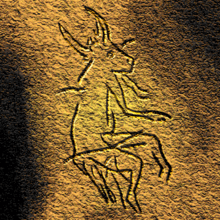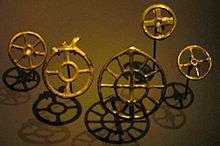Prehistoric religion
Prehistoric religions are the religious beliefs and practices of prehistoric peoples. The term may cover Paleolithic religion, Mesolithic religion, Neolithic religion and Bronze Age religions.
| Part of a series on | ||||||||||
| History of religions | ||||||||||
|---|---|---|---|---|---|---|---|---|---|---|
|
|
||||||||||
|
Study of religion |
||||||||||
|
Timeline
|
||||||||||
|
Religions |
||||||||||
Paleolithic
Intentional burial, particularly with grave goods, may be one of the earliest detectable forms of religious practice (the onset of burial itself being a canonical indicator of behavioral modernity) since, as Philip Lieberman suggests, it may signify a "concern for the dead that transcends daily life".[1]

A number of archeologists propose that Middle Paleolithic societies such as Neanderthal societies may also have practiced early forms of totemism or of animal worship. Emil Bächler in particular suggests (based on archeological evidence from Middle Paleolithic caves) that a widespread Middle Paleolithic Neanderthal bear-cult existed (Wunn, 2000, p. 434-435). A claim that evidence was found for Middle Paleolithic animal worship c 70,000 BCE (originating from the Tsodilo Hills in the African Kalahari desert) has been denied by the original investigators of the site.[2][3] Animal cults in the following Upper Paleolithic period, such as the bear cult, may have had their origins in these hypothetical Middle Paleolithic animal cults.[4]
Animal worship during the Upper Paleolithic intertwined with hunting rites.[4] For instance, archeological evidence from Paleolithic art and from bear remains reveals that the bear cult apparently had a type of sacrificial bear ceremonialism in which a bear was shot with arrows, then finished off with a shot in the lungs and ritualistically buried near a clay bear-statue covered by a bear fur, with the skull and the body of the bear buried separately.[4]
Neolithic
There are no extant textual sources from the Neolithic era, the most recent available dating from the Bronze Age, and therefore all statements about any belief systems Neolithic societies may have possessed are glimpsed from archaeology.
Jacques Cauvin suggested that the Neolithic Revolution was influenced by an important theme he termed the "Revolution of the Symbols", suggesting the birth of "religion" in the Neolithic. He argued that Neolithic humans were influenced by a change in thinking as much as changes in the environment and noted a series of stages in this process.[5] His work suggested important concepts in the evolution of human thinking, by examining figurines and early art depicting first women as goddesses and bulls as gods, he suggested several important ideas about the evolution of perception and duality.[6]
The structures known as Circular Enclosures built in Central Europe during the 5th millennium BCE have been interpreted as serving a cultic function. In the case of the Goseck circle, remains of human sacrifice were found. Many of these structures had openings aligned with sunset and/or sunrise at the solstices, suggesting that they served as a means of maintaining a lunisolar calendar. The construction of Megalithic monuments in Europe also began in the 5th millennium, and continued throughout the Neolithic and in some areas well into the early Bronze Age.
Marija Gimbutas, pioneer of feminist archaeology, put forward a notion of a "woman-centered" society surrounding "goddess worship" in Neolithic Europe. The Neolithic "matristic" cultures would have been replaced by patriarchy only with the arrival of the Bronze Age. Gimbutas' views on this matter do not have widespread support today.[7]
- Remains of a statue in the Tarxien Temples c. 2800 BCE
 A detail from the Megalithic temple of Mnajdra c. 2800 BCE
A detail from the Megalithic temple of Mnajdra c. 2800 BCE- According to Gimbutas: Hourglass Neolithic Goddess with Bird arm, from Cucuteni culture 5000-3500 BCE
- According to Gimbutas, a Cucuteni culture Goddess representation; around 4900-4750 BCE
- Goddess representation 3800-3600 BCE, Cucuteni Culture
- Goddess council around 4900-4750 BCE
 A clay model considered by some historians to be a sanctuary; Cucuteni–Trypillia culture
A clay model considered by some historians to be a sanctuary; Cucuteni–Trypillia culture- Bull representation, having a ritualistic role according to Gimbutas
Bronze Age
Reconstructions
The early Bronze Age Proto-Indo-European religion (itself reconstructed), and the attested early Semitic gods, are presumed continuations of certain traditions of the late Neolithic.
Bronze Age Europe
Hints to the religion of Bronze Age Europe include images of solar barges, frequent appearance of the Sun cross, deposits of bronze axes, and later sickles, so-called moon idols, the conical golden hats, the Nebra skydisk, and burial in tumuli, but also cremation as practised by the Urnfield culture.
 The Avanton Gold Cone, c. 1500-1250 BCE (Avanton, France).
The Avanton Gold Cone, c. 1500-1250 BCE (Avanton, France). "Fire dogs", dating to the 11th to 9th centuries BCE, found in the Canton of Zurich, Switzerland, kept at the Swiss National Museum
"Fire dogs", dating to the 11th to 9th centuries BCE, found in the Canton of Zurich, Switzerland, kept at the Swiss National Museum "Wheel pendants", dating to the second half of the 2nd millennium BCE, found in Zürich, kept in the Swiss National Museum, showing the "sun cross" and variant shapes
"Wheel pendants", dating to the second half of the 2nd millennium BCE, found in Zürich, kept in the Swiss National Museum, showing the "sun cross" and variant shapes The Trundholm sun chariot, Nordic Bronze Age, c. 1400 BCE (Denmark).
The Trundholm sun chariot, Nordic Bronze Age, c. 1400 BCE (Denmark).
Iron Age
While the Iron Age religions of the Mediterranean, Near East, India and China are well attested in written sources, much of Iron Age Europe, from the period of about 700 BCE down to the Great Migrations, falls within the prehistoric period. There are scarce accounts of non-Mediterranean religious customs in the records of Hellenistic and Roman era ethnography.
- Scythian mythology (Herodotus)
- Indian mythology
- Celtic polytheism (Posidonius)
- Paleo-Balkan mythology
- Germanic polytheism (Tacitus)
- Slavic polytheism (Procopius)
- Mythology of the Turkic and Mongolian peoples
In the case of Circumpolar religion (Shamanism in Siberia, Finnic mythology), traditional African religions, native American religions and Pacific religions, the prehistoric era mostly ends only with the Early Modern period and European colonialism. These traditions were often only first recorded in the context of Christianization.
For these reasons, the interpretations and understanding of the Iron Age cult in Europe has to rely primarily on archaeological material.
See also
- Ancestor worship
- Anthropology of religion
- Bear worship
- Bruniquel Cave
- Bull worship
- Circular ditches
- Fire worship
- Ggantija
- Göbekli Tepe
- Henge
- History of religions
- Horse sacrifice
- Matriarchal religion
- Megalithic tomb
- Moon worship
- Mother Goddess
- Religions of the ancient Near East
- Sacred king
- Sun worship
- Tarxien Temples
- Urmonotheismus
Notes
- ^ Christopher L. C. E. Witcombe, "Women in the Stone Age," in the essay "The Venus of Willendorf" (accessed March 13, 2008).
References
- Uniquely Human. 1991. ISBN 0-674-92183-6.
- World's Oldest Ritual Discovered -- Worshipped The Python 70,000 Years Ago The Research Council of Norway (2006, November 30). World's Oldest Ritual Discovered -- Worshipped The Python 70,000 Years Ago. ScienceDaily. Retrieved March 2, 2008, from https://www.sciencedaily.com/releases/2006/11/061130081347.htm
- Robbins, Lawrence H.; Alec C. Campbell; George A. Brook; Michael L. Murphy (June 2007). "World's Oldest Ritual Site? The "Python Cave" at Tsodilo Hills World Heritage Site, Botswana" (PDF). NYAME AKUMA, the Bulletin of the Society of Africanist Archaeologists (67). Archived from the original (PDF) on 28 September 2011. Retrieved 1 December 2010.
- Karl J. Narr. "Prehistoric religion". Britannica online encyclopedia 2008. Retrieved 2008-03-28.
- Olivier Aurenche, Jacques Cauvin et la préhistoire du Levant, Paléorient, Volume 27, Number 27-2, pp. 5-11, 2001.
- Jacques Cauvin; Trevor Watkins (2000). The birth of the Gods and the origins of agriculture. Cambridge University Press. ISBN 978-0-521-65135-6. Retrieved 1 April 2011.
- Archaeologist Sarah M. Nelson criticizes Gimbutas suggesting that she used the same techniques used in the past to disparage women but in this case to glorify them, and quotes another archaeologist, Pamela Russell, as saying "The archaeological evidence is, in some cases, distorted enough to make a careful prehistorian shudder". See Nelson, Sarah M (2004). Gender in archaeology: analyzing power and prestige. AltaMira Press. p. 132. ISBN 978-0-7591-0496-9.